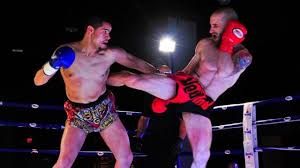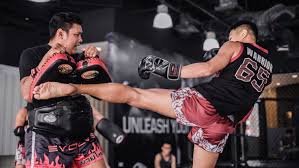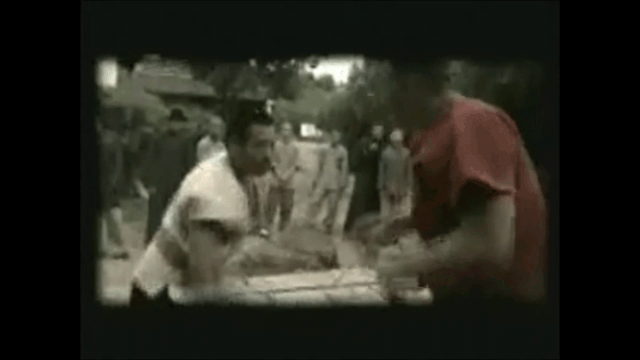Agreed. Though in this case this was about strategy. My point was that it’s not in the system if the student has to figure it out. That doesn’t mean it doesn’t fit or belong, but that the instructor left it out. So in this usage, I’m referring to the system delivered to the student by that instructor, not the larger System (or art).I think it depends on how the system is being defined. Seems to me that a lot of people define the system by the body of techniques. I don’t think that’s the best way. I think a better way is to define the principles, with a body of techniques that help illustrate how the principles are put to use. That leaves the door wide open to have room for any technique, as long as it can fit within the principles. I like to say: even something that isn’t a “proper” technique at all can find a place within the system as an individual may use it.
So then, is “it” in the system or not, meaning a particular technique? Yes, if it fits within the principles, because you can do anything you want with the system, even if not explicitly taught by the teacher.
Navigation
Install the app
How to install the app on iOS
Follow along with the video below to see how to install our site as a web app on your home screen.
Note: This feature may not be available in some browsers.
More options
Style variation
You are using an out of date browser. It may not display this or other websites correctly.
You should upgrade or use an alternative browser.
You should upgrade or use an alternative browser.
Is Wing Chun being used the wrong way in fighting?
- Thread starter geezer
- Start date
You’re arguing a claim I didn’t make. And most of e post you quoted was to clarify that. I feel like you’ve decided what I said without really reading my post.(QUOTE="gpseymour, post: 2032709, member: 27826"]I said "difference in application". Meaning, you're applying it differently.,)
I think this application definition might have swerved into personal semantics. I view application as what I want the technique to do, like do I want it to bridge or do I want it to break something. Where the technique bridges (over or under) or where it breaks does not change its application. But I can completely see where you are coming from if your saying where the technique lands changes its application. Just a different definition.
I don't think it's an outrageous claim to make that a system can contain a technique, strategy or application that one single instructor or maybe a couple of instructors don't know or have forgotten.
If someone is teaching it in the system elsewhere I don't think you can argue in good faith that it isn't in the system because the aforementioned instructors don't teach it.
It kinda feels that your arguing that a martial system should be limited to what only one particular instructor (or set of instructors) teach/es, and anything outside of that is not in the system. I may have misunderstood, but if that is what your arguing i have to say I do disagree with that.
I see that you mentioned different versions but I am confused as to what you might mean by system, each version is its own system maybe? But if that's the case if one instructor teaches one application of the technique and another teachers two, whose is the system? both separate systems?, the one with more? or if I'm the student of the instructor who teacher one maybe his is the "true" system?
That’s obviously a different situation, then.Strategy is being taught, it’s just that not everyone understands it the same way.
If the students have to figure out themselves, they have a bad teacher. Students are very smart about whether a teacher just wants the money, or the teacher is willing to teach.if the student has to figure it out.
Flying Crane
Sr. Grandmaster
I understand your point. I guess what I’m getting at is that no instructor can teach a student everything, meaning all that is possible within a system. It’s not possible. All he can do is teach how things work and how they work together and give a student a vision of what is possible and encourage the student to use it creatively. So there is actually a lot for the student to figure out for himself, through no fault of the teacher. Then what is “in” the system depends on the individual.Agreed. Though in this case this was about strategy. My point was that it’s not in the system if the student has to figure it out. That doesn’t mean it doesn’t fit or belong, but that the instructor left it out. So in this usage, I’m referring to the system delivered to the student by that instructor, not the larger System (or art).
Flying Crane
Sr. Grandmaster
The Sifu needs to teach how the foundation works and how the principles are expressed through a wide range of techniques, and convey a vision of what is possible But a Sifu cannot possibly teach all that is possible or every way that a student can adapt with the methodology of the system. So there is actually a lot that a student does need to figure out for himself, but if the Sifu has done his job well, then the student will have the tools to do so.If the students have to figure out themselves, they have a bad teacher. Students are very smart about whether a teacher just wants the money, or the teacher is willing to teach.
The man wins the prize!I think he is referring to how a boxer/ring fighter will "circle away from the power hand" using small slices of a pie or degrees on a clock. They tend to go in a slow circle...
I also think moving in a circle must be deeply ingrained in humans since so many seem to fall to it with out thinking
I wrote a post to explain the reason, I then realize that since the roundhouse kick is not emphasized in the WC system, my post may not apply to a WC thread.
Here is my reason why I want my opponent to switch sides in fighting.
When my opponent and I both have right side forward (uniform stance), my left back leg can only kick on his back (not a good target). My right leg is too close to my opponent and roundhouse kick is not powerful for that distance. I can use front, or side kick, but since my opponent stands side way, my target is limited.
In this pic, the person on the right kicks on his opponent's back which is not a good target.

When my opponent switch sides and changes from right leg forward into left leg forward, his center line will scan across my body. If I can catch that good timing, my left leg roundhouse kick can hit on his chest (a full target).
In this picture, the person on the left switches side from right leg forward into left leg forward. The person on the right kicks out his left back roundhouse kick without any hesitation.
In sparring, you either wait for this opportunity to happen, or you try to create this opportunity for yourself.

I understand what you are saying.
Since I teach constant movement lead leg changing happens.
I am not sure I agree about attacks to the back. A good kidney shot is a fight ender and will stun. The ribs can also be broken easier than from the front depending on angle.
This is the major difference between Chinese wrestling and Judo. Chinese wrestlers like to drag their opponent in circle.I also think moving in a circle must be deeply ingrained in humans since so many seem to fall to it with out thinking
It's a good method to break apart your opponent's grip.

I agree. I'm drawing a distinction between the larger System (the entire art) and the systematic transfer to the student. You can't include everything (thus, there are techniques that fit within the System that may not be taught explcitly), but major pieces (like strategy) not being taught is the point I'm considering.I understand your point. I guess what I’m getting at is that no instructor can teach a student everything, meaning all that is possible within a system. It’s not possible. All he can do is teach how things work and how they work together and give a student a vision of what is possible and encourage the student to use it creatively. So there is actually a lot for the student to figure out for himself, through no fault of the teacher. Then what is “in” the system depends on the individual.
wckf92
Master of Arts
The man wins the prize!
What do I win? A free lesson next time I'm out in NM?
Don't think you need any lessons! would be happy to show you whatever you were interested in though.What do I win? A free lesson next time I'm out in NM?
This is the major difference between Chinese wrestling and Judo. Chinese wrestlers like to drag their opponent in circle.
It's a good method to break apart your opponent's grip.

drop bear
Sr. Grandmaster
Agreed. Though in this case this was about strategy. My point was that it’s not in the system if the student has to figure it out. That doesn’t mean it doesn’t fit or belong, but that the instructor left it out. So in this usage, I’m referring to the system delivered to the student by that instructor, not the larger System (or art).
Here is kit dale's theory on training. And getting good really fast.
It involves a lot of onus on the student figuring things out. Sort of.
No striking is used in that training.Nice drills. remind me a bit of lop sau drill, Do you incorporate striking into this drill at some point?
The training is to drag your opponent in circle. When your opponent shifts weight from 1 leg to another, you take advantage on it. Your opponent can resist against you, or yield into you. In both cases, you can borrow his force.
Last edited:
You will need a strong grip for this. Your opponent will get a black mark on his upper arm.Do you also do this drill grabbing the Biceps elbow forearms as well? With the proviso that training partners have to have trimmed fingernails.
Old CMA saying said, "If your opponent has clothes, grab on his clothes, otherwise, grab on his skin."

However if you are ring fighting one thing is cutting the clock. We also use fast foot work. So always be in motion and keep angles constantly changing, keep changing distance until you are comfortable,receive what comes ie move in when range is entered do not move away.
Do you use western boxing footwork when "circling away from the opponent’s power hand" to apply “cutting the clock” thus maintaining boxing range? Or do you utilize wing chun stepping/footwork when “cutting the clock” to continually close the range with every step to get in closer?
Can you elaborate on what you mean by “keep changing distance until you are comfortable,receive what comes”?
Do you mean constantly opening and closing distance by stepping away and towards the opponent until the opponent over extends or over commits by stepping into your range.
Is this a good example of what you are referring to in regards to “keep changing distance”?
Do you use western boxing footwork when "circling away from the opponent’s power hand" to apply “cutting the clock” thus maintaining boxing range? Or do you utilize wing chun stepping/footwork when “cutting the clock” to continually close the range with every step to get in closer?
Can you elaborate on what you mean by “keep changing distance until you are comfortable,receive what comes”?
Do you mean constantly opening and closing distance by stepping away and towards the opponent until the opponent over extends or over commits by stepping into your range.
Is this a good example of what you are referring to in regards to “keep changing distance”?
To be simple, for the most part. I always use wing chun footwork. Another rule. never chase. If contact is made and the opponent is backing out, 3 steps is the max you can chase
If he can't hit you and you can't hit him then there is no fight and I am ok with that. yes when he closes to that "B" range you attack. When he closes to do the tag tag tag stuff you should be receiving which mean moving in on him.You don't stay there and you don't move back. When range is made you move into his tag tag tag.
Similar threads
- Locked
- Replies
- 93
- Views
- 13K
